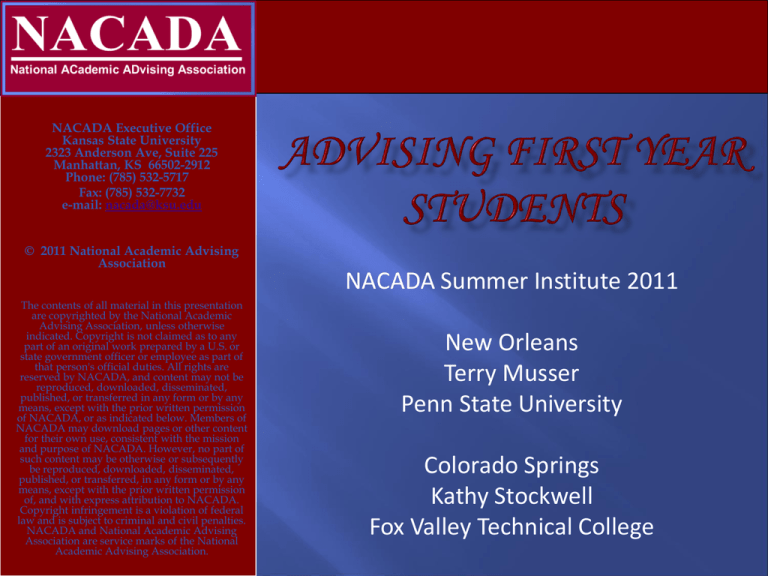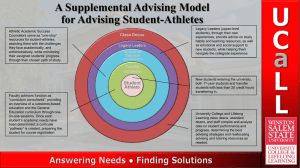
NACADA Executive Office
Kansas State University
2323 Anderson Ave, Suite 225
Manhattan, KS 66502-2912
Phone: (785) 532-5717
Fax: (785) 532-7732
e-mail: nacada@ksu.edu
© 2011 National Academic Advising
Association
The contents of all material in this presentation
are copyrighted by the National Academic
Advising Association, unless otherwise
indicated. Copyright is not claimed as to any
part of an original work prepared by a U.S. or
state government officer or employee as part of
that person's official duties. All rights are
reserved by NACADA, and content may not be
reproduced, downloaded, disseminated,
published, or transferred in any form or by any
means, except with the prior written permission
of NACADA, or as indicated below. Members of
NACADA may download pages or other content
for their own use, consistent with the mission
and purpose of NACADA. However, no part of
such content may be otherwise or subsequently
be reproduced, downloaded, disseminated,
published, or transferred, in any form or by any
means, except with the prior written permission
of, and with express attribution to NACADA.
Copyright infringement is a violation of federal
law and is subject to criminal and civil penalties.
NACADA and National Academic Advising
Association are service marks of the National
Academic Advising Association.
NACADA Summer Institute 2011
New Orleans
Terry Musser
Penn State University
Colorado Springs
Kathy Stockwell
Fox Valley Technical College
“The largest proportion of
institutional leaving occurs in
the first year and prior to the
beginning of the second year.
For this reason alone, the
first year has become a
special object of institutional
policy aimed at reducing
student attrition.”
V. Tinto
Leaving College
Past view: “look to your right, then look to
your left....one of you won’t be here after
the first year”
Today: facilitate student success and
provide support systems to help all firstyear students succeed
“The task of advising is
concentrated in the
opening days of
registration and
enrollment and consists
of aiding students in the
selection of courses.”
Handbook of College and
University Administrators
Asa Knowles, Editor 1960
Advising:
viewed as retention tool
assists students in academic, social and career
development
far more than scheduling classes
Anxiety vs false sense of confidence
Interest in career preparation
Frequent isolation
Difficulty making friends
Failure to “connect” with the institution
Often underprepared for college level work
Difficulty with
time management
“First-year students are dropping
out of school in alarming numbers:
one in four freshmen at 4-year
institutions and one in two
freshmen at 2-year institutions
fail to return for a sophomore
year.”
Crisis at the Core
Preparing All Students for College and Work
ACT, 2004
1.
2.
3.
4.
5.
Too much fun at the expense of classes and
grades
A sense of not belonging; a sense of
isolation, homesickness
Academically unprepared, burned-out on
education
Financial constraints;
low on funds
Personal family issues
6.
7.
8.
9.
10.
Academic climate fit
Choice of wrong major; major not offered
Lack of advising, guidance
Demands from part-time or full-time
employment
Move to a different geographic location
Randall S. Hansen, Ph.D.
“Good advising may be the single
most underestimated
characteristic of a successful
college experience.”
Richard Light
Traditionalists: 1934-1945
Baby Boomers: 1946-1964
Generation X: 1965-1980
Generation Y/Millenials: 1981-2000
Lancaster & Stillman, 2002
o
o
o
o
o
o
o
o
o
Adaptable
Technologically savvy
Ability to grasp new concepts
Efficient multi-taskers
Impatient
Skeptical
Blunt and expressive
Image-driven
The “me” generation
o
o
o
o
o
o
Short attention spans
Often under-prepared for college-level work
Interested in career preparation
Have the “fast food” mentality
Have strong relationships
with their families
Very service-oriented
o
o
o
o
o
Be undecided
Change majors
Fail a course
Take extra time
Drop out
Expect
7%
12
1
8
1
Experience
20%
65-85
16
60
40
o
o
o
o
o
Expect
Transfer colleges 12%
Work in college
36
Seek counseling
6
Need tutoring
15
Seek career
guidance
5
Experience
28%
60
27
20
25
UCLA Freshman Studies (Astin), ACT Student Opinion Survey
“Provides assistance mediating the
dissonance between student expectations
and the realities of the educational
experience.”
Wes Habley, 1981
NASPA Journal
Theme
o
Become familiar with
academic life
o
Set goals
Needs/Tasks
o
Learn about college
resources and support
o
o
Become acquainted with
college missions,
academic leaders, major
program
Learn registration and
class scheduling
Gary Kramer
Advising Students at Different
Educational Levels
Theme
o
Make commitments
o
Use Resources
Needs/Tasks
o
Understand major and
university
requirements
o
Understand policies
and academic options
Gary Kramer
Advising Students at Different
Educational Levels
Theme
o
Setting expectations and
responsibilities
Needs/Tasks
o
Time and effort required
for success
o
Assess match between
interests and abilities
and major/career choice
Gary Kramer
Advising Students at Different
Educational Levels
“Four institutional
conditions stand out as
supportive of retention:
information/advice,
support, involvement, and
learning.”
Tinto (1999)
o
Ensure higher ed expectations are clearly articulated
at secondary ed level.
o
ID strengths and needs of before classes begin.
o
Establish a warm and open relationship.
o
Be accessible.
o
o
Teach students policies/procedures while stressing
their responsibilities.
Explain program requirements to advisees.
o
Early alert warning system
o
Support groups for returning adults
o
Help students connect relevance of course curriculum to
college experience and career development
o
Assist in designing appropriate schedules
o
Introduce campus resources
o
Make appropriate referrals
o
Explore purpose and value of college education
o
Aid student with time management skills
o
Help advisees develop study skills, overcome
test anxiety, and achieve course goals.
o
o
o
Aid in developing realistic career goals
Help them make their own decisions and take
responsibility for their education
Encourage them to participate in co-curriculars
“Sometimes we look so intently
toward the pinnacle that we
stumble over the steps
leading to it. Development
begins just where you are.”
Mrs. Herman Stanley
Orientation
Advising Center
Faculty Advising
Peer Advising/Mentoring
First-year seminar
Learning Communities
Residence Hall-based advising
Multicultural Centers
Interventions with at-risk students
Learning assistance centers
Early alert system
WHERE ARE THE POTENTIAL ADVISING
INTERVENTIONS?
Student applies
Student accepts offer
Student takes placement tests and completes online survey
Student prepares for academic orientation -- first advising experience
Student participates in academic orientation
Student has traditional orientation before classes begin
Student takes first-semester courses
Student meets with assigned academic adviser
Student communicates with adviser and vice versa
Student plans next semester schedule
Student takes second-semester courses
Student communicates with adviser and vice versa
Student meets with assigned academic adviser
Caring attitude
Efficiency
Respect
Good “customer service”
Responsiveness to needs
Enthusiasm for what they’re doing
A willingness to go the extra mile
Humor
What can YOUR college
do to increase retention
of first-year students?






